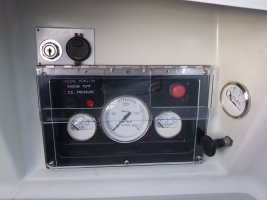First, the fuel gauge is wildly inaccurate. The standard gauge is linear and the bottom 2" of my tank holds almost 2 gallons and the top 2" holds 18 gallons. This essentially makes the gauge useless.
Second, you should never trust a gauge when you can't pull over to the curb and flag Triple-A. When I was flapping around in the sky, it was pounded into you to dip the tank prior to every flight. Running out of fuel was usually fatal so don't trust a gauge that can fail. I tend to think in terms of running out of fuel in the middle of the Dent Rapids or some exciting place like that.
I paid to have my tank calibrated at 2" intervals and that info programed into a programable sensor. I now can read that at the tank and the chart table. More importantly, I have kept track of my hours and amounts of fuel since I bought Terra Nova. She burns 4.1gph. [Bob corrects this typo in Post #17] With an accurate tank capacity and burn rate, it is easy to calculate hours at refill. I post that on the instrument panel over the Chart Table. Because my tank was calibrated, that info is now free. Unfortunately, only the 34 has that tank.
I realize that that is not very important for those of us that pop in and out of the same harbor and take an occasional weekend cruise. For those of us who take serious cruises in the great north, running out of fuel could be fatal.
Unfortunately, I am away from home and not sure of my return date. If you are really anxious, I will attempt to retrieve the info remotely.

